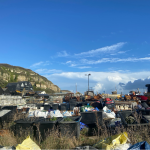We ran our first-year undergraduate Geography Earth and Environment field skills trips at the beginning of November. All of our first-year students participated in three field trip days – Human Geography, Physical Geography and Environmental Geography. I co-led the Human Geography day with my colleague Dr Paul Gilchrist.
Our trip involved a full day out in Hastings, a seaside town on the South East coast of England, approximately an hours drive east of Brighton. Hastings is an interesting place to explore geographical issues of regeneration, placemaking, inclusion and violence – it is one of the most deprived seaside towns in the UK, whilst simultaneously becoming a desirable place to live as gentrification is transforming certain areas making it an attractive place for young professionals. I have conducted some research on deprivation in Hastings, focusing on the lives on young white working-class men. On this field trip we asked the students to take observational data – including what they see, hear, smell, touch and feel. We encouraged them to use their ‘bodies as tools of research’ – which means thinking about the senses as they move through spaces – to explore how Hastings is ‘made’ and ‘created’.
With this intension in mind, Paul and I started the day in St Leonards asking students to talk about their initial impressions of Warrior Square and Norman Road – a place that is rapidly gentrifying. They all commented on the attractive buildings, well-kept gardens, hipster cafes (I even sampled the coffee, for research) and art galleries. We then questioned this, using my work on austerity and young working-class men – many of the men who we worked with lived around Warrior Square. This led to discussions around poverty and violence and the way they may get hidden or policed in public spaces, which many of our students were surprised to hear.
Out fieldtrip then took us to down to ‘Bottle Alley’ and an underpass where we spoke about how this space feels – using smells, sounds and sight – and who it might be safe for (see image 1). Then we headed off to the pier to talk about the different ways that people imagine seaside towns and who piers should be ‘owned’ by – Hasting Pier is a point of contention in the town since it was sold to a private investor.
After lunch, we headed over to the Old Town, walking along through the sea front amusements and the fair ground to the working fishing beach (see image 2). Here we asked students to use their observations skills to ‘make sense’ of this area, examining the mixture of the old and new, and how certain type of heritage are held onto in the processes of placemaking. Our students were interested in the people selling their freshly caught fish, and the interesting wooden buildings but also the modern art gallery that has been built right in front of it – lots more here on exclusion of certain people from cultural spaces.
We then headed through the old town, looking at the ‘cute’ and ‘cosy’ streets, we started to make more connections around public space regeneration and local communities. We questioned what it means for places to make us feel warm and fuzzy by linking these ideas to issues of Englishness, whiteness and class and what imaginations of places might be used to make places. We ended our trip with a (steep) walk up to West Hill to take in the views of Hastings and the ways the place is ‘put together’ (see image 3).
Our field skills week was rounded off with a panel of experts from Hastings Council and a local educational charity, where students had developed questions based on what they had seen in the field days. This led to some exciting conversations around the issues with the pier, the future of the town and the regeneration projects that might try to tackle poverty. Overall, we had three great sunny days in Hastings, examining different spatial processes which our new Geographers are grappling with across their other modules and we look forward to future trips in and around Hastings to critically explore how it continues to be remade, recreated and regenerated.




Published by